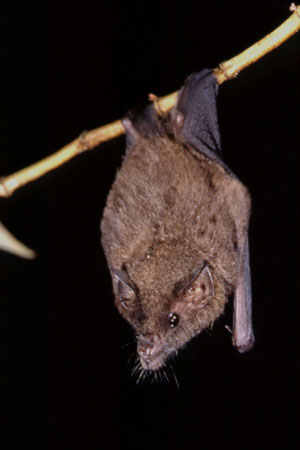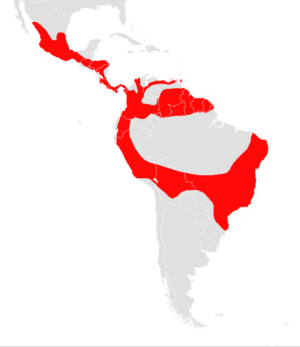Geoffroy's tailless bat facts for kids
Quick facts for kids Geoffroy's tailless bat |
|
|---|---|
 |
|
| Conservation status | |
| Scientific classification | |
| Genus: |
Anoura
|
| Species: |
geoffroyi
|
 |
|
| Geoffroy's tailless bat range | |
The Geoffroy's tailless bat (Anoura geoffroyi) is a special kind of bat. It belongs to a family called phyllostomid bats. You can find these bats living in the warm, tropical areas of the Americas.
Contents
About Geoffroy's Tailless Bat
Geoffroy's tailless bat is a medium-sized bat. It is about 7 cm (2.8 in) long. It usually weighs between 10 to 15 g (0.35 to 0.53 oz). Its fur is dark to dull brown. The fur on its belly is greyish-brown. Its neck and shoulders have silvery-grey fur.
The bat's wings are black or very dark brown. The skin between its legs is small and covered in hair. As its name suggests, this bat does not have a tail! It has a long nose and a lower jaw that sticks out. Its ears are short and round. Its tongue is long and thin. The tip of its tongue has tiny bumps called papillae. These bumps help the bat drink nectar.
Male and female bats are usually the same size in Brazil. But in Trinidad, female bats have slightly longer forearms.
Where These Bats Live
Geoffroy's tailless bat lives in many places. You can find it from northern Mexico through Central America. It also lives across northern South America. It goes down through Peru to parts of Bolivia and Brazil. These areas are just south of the Amazon Basin. These bats have also been seen in Trinidad and Grenada.
These bats like to live in wooded areas. They are found at heights between 400 and 2,500 m (1,300 and 8,200 ft). Their homes include pine and oak forests. They also live in cloud forests and cerrado areas. Sometimes, they live on farms too.
Scientists recognize three main types, or subspecies, of this bat:
- A. g. geoffroyi — Found in Bolivia, Brazil, eastern Colombia, Venezuela, and The Guianas.
- A. g. lasiopyga — Found in Mexico, Central America, western Colombia, and Ecuador.
- A. g. peruana — Found only in Peru.
What Geoffroy's Tailless Bats Eat
These bats mostly eat insects. About 90% of their food is moths and beetles. They also eat other arthropods. But they don't just eat insects! They also enjoy some fruit. They lap up nectar and pollen from many different flowers. In some places, they might even eat only nectar.
Bat Behavior
Geoffroy's tailless bats are nocturnal. This means they are active at night. During the day, they rest in caves near water. They might rest alone or in groups. Some groups can have up to 300 bats. But it's more common to see groups of 20 to 75 bats.
This bat is a very fast flyer. It can even hover in the air. It uses both its eyes and echolocation to find its way. Echolocation is like using sound waves to "see." Their hearing is best for sounds between 65 and 75 kHz. Other bats in the area might eat similar insects. So, Geoffroy's tailless bat might fly at different heights to avoid competing for food.
Life Cycle and Reproduction
Geoffroy's tailless bats usually mate between March and August. This time is during the rainy season. It helps make sure the baby bats are born when there is plenty of food. However, the exact mating season can change depending on where the bats live.
A mother bat carries her baby for four months. Baby bats are born in different months in different places. For example, they are born in July in Nicaragua. In Peru, they are born in June. In Costa Rica, births happen in March.


